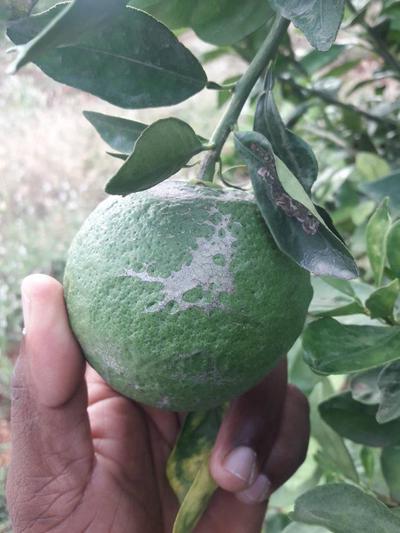Wind Damage on Citrus
Wind Damage on Citrus
Nyingine
Kwa Ufupi
- In the long term, wind can cause diverse changes in tree growth, anatomy and morphology.
- Physical damage includes branch or twig breaking, fruit corking and sandblasting, which causes abrasion and removal of tissue.
- In severe cases, fewer fruits are produced, quality is affected and yields losses may be expected.
Inaweza pia kupatikana kwenye
Dalili
Symptoms are often confused with thrips damage. Young trees' upper roots and bark at ground level show signs of abrasion caused by sand corns (also known as sandblasting). Lesions leaves and stems are also caused by abrasion but damage there is much more significant. The growth rate and yield can be reduced by wind stress, visible in fewer or no fruits on the side of the tree exposed to wind. Later in the season young fruits (8mm in diameter) are most prone to wind damage. Single or multiple transverse or diagonal grayish scars are visible across the skin. In comparison with thrips damage, wind stress is characterized by small patches of clean tissue on the fruit, whereas thrips leave continuous scarring. Strong winds can break branches and bend or even overthrow trees.
Mapendekezo

Udhibiti wa Kiasili
First evaluate the damage. According to its extent and the growth stage, determine if the trees can be salvaged. Remove damaged branches and fruits with cutting or pruning tools. During particularly wet weather, apply organic pastes where bacterial or fungal diseases are of concern.

Udhibiti wa Kemikali
Always consider an integrated approach with preventive measures and biological treatment if available. Treatments will depend on the growth stage and the severity of the damage. In severe cases, treatments should be focused on the prevention of fungal and bacterial diseases, for example with the clear-cutting of the damaged branches and the application of antifungal and antibacterial pastes.
Ni nini kilisababisha?
Symptoms are caused by wind, and are particularly of concern in unprotected areas, with no windbreaks. If wind is frequent and/or strong, a large percentage of the citrus harvest may be qualitatively downgraded or rejected. Markings on young fruits are caused by older leaves being blown across the surface. The discoloration results as the formation off a protective, corky layer. Once fruit is about 3 cm in size, the skin has hardened, and damage is more likely to be caused by the scratching of dry twigs and branches. The damage to tissues is an opportunity for bacteria and fungus to enter and colonize the tissues and cause more damage. Specifically dry winds can damage trees through leaf fall, windburn and scorch, inevitably resulting in dying of leaves and scarring of fruits.
Hatua za Kuzuia
- Install permanent or occasional windbreaks following wind speed, direction and frequency patterns.
- Plant trees following the orientation of the wind.
- Make sure to repair and manage windbreaks to protect trees.
- Keep the soil moisture high when wind is forecast.
- Consider also applying additional nitrogen to encourage new growth after major damage.
- In case of extreme wind gusts, or different wind directions, install several windbreaks.
- Selective pruning following the direction of main wind is recommended.
- Also, do not forget to prune out dead wood after the harvest to avoid damage the following season.



